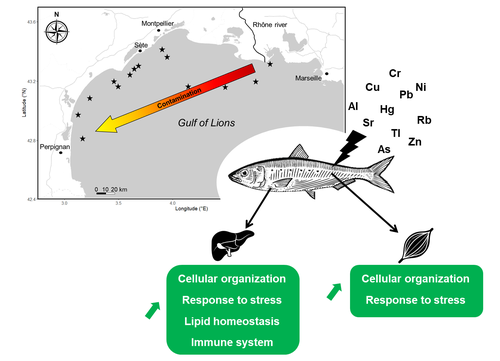
VIGNATI Davide Anselmo Luigi
- Laboratoire Interdisciplinaire des Environnements Continentaux UMR7360, Université de Lorraine and CNRS, Metz, France
- Aquatic ecotoxicology, Bioaccumulation/biomagnification, Bioassays, Chemical speciation
- recommender
Recommendation: 1
Review: 1
Recommendation: 1

Molecular response to multiple trace element contamination of the European sardine
Molecular-level responses highlight physiological stress in muscle and liver tissue of apparently healthy European sardine specimen
Recommended by Davide Anselmo Luigi Vignati and Abdulsamie Hanano based on reviews by Sophie Prud'homme, Roberta Bettinetti and 1 anonymous reviewerFish is an essential component of healthy human diets and the preservation of fish stocks and other marine resources is included as a target of Sustainable Development Goal 14 ‘Conserve and sustainably use the Oceans, Sea and Marine Resources for Sustainable Development’ (UNEP). However, several fish stocks remain in sub-optimal (or worse) conditions due to overfishing and a range of stressors including chemical pollution. Chemical pollution can result in high level of chemicals in fish making it unsuitable for human consumption. Furthermore, the occurrence of chemical-related physiological stress in otherwise apparently healthy fish requires additional research efforts. In natural environments, further complexity arises from fish being simultaneously exposed to multiple contaminants/stressors as opposed to laboratory investigation usually dealing with one or very few contaminants/stressors at a time (Schäfer et al., 2023).
Beauvieux et al. (2024) examined the possible role of accumulation of multiple elements on the physiological status of first-year-of-life specimen of European sardine collected in the Gulf of Lions (northeastern Mediterranean Sea) as a contributing factor to the declining sardine population observed in the region since 2008. The ultimate objective of the paper was to identify potential biomarkers of stress in fish otherwise not exhibiting any anomalies in body condition, in agreement with the principles of chemical stress ecology put forward by van der Brink (2008).
Out of a total of 105 specimen, individuals were selected according to the lowest (n = 14) or highest (n = 15) levels of contamination and subject to proteomic analysis of liver and red muscle tissues. A first Principal component analysis on all specimen highlighted the possible influence of the Rhone river as a source of geogenic and anthropogenic elements to the Gulf of Lions.
A second PCA performed only on specimen selected from proteomics analysis allowed to identify three elemental mixtures possibly responsible for the observed physiological effects. Proteomic analysis in liver and muscle tissue identified both similarities and differences in the pathways involved in response to stress. More in detail, the expression patterns of Myosin and Myomesin were downregulated in red muscle for highly exposed specimen, which suggests possible effects of elemental accumulation on the locomotion abilities of Mediterranean sardines. Pathways involved in lipid metabolism and immune processes were up-regulated in liver, pointing to increased energetic costs for maintaining the overall fish homeostasis in presence of metal contamination. It is interesting to note that these effects were observed at concentrations below the legal thresholds for human consumption (except for As), albeit such thresholds are available only for a limited number of elements (Cd, Pb, Cd, As and inorganic Sn) (EU, 2023).
Although stressors other than trace elements could contribute to the observed molecular responses, as acknowledged by the authors themselves, Beauvieux et al. (2024) show that biological responses at lower levels of biological organization can provide both early-warning indications of potential adverse effects in the long term and better understanding of drivers of population decline. By advancing our knowledge of the physiological responses to trace elements and identifying potential biomarkers, this study lays the groundwork for more effective monitoring and conservation strategies. Further studies addressing the combined effects of multiple environmental stressors remain essential to develop holistic approaches to marine ecosystem management and species conservation.
References
Beauvieux A., Fromentin J.-M., Saraux C., Romero D., Couffin N., Brown A., Metral L., Bertile F., Schull Q. (2024). Molecular response to multiple trace element contamination of the European sardine. bioRxiv, ver. 4 peer-reviewed and recommended by Peer Community in Ecotoxicology and Environmental Chemistry. https://doi.org/10.1101/2024.02.16.580673
EU (2023). Commission Regulation (EU) 2023/915. https://eur-lex.europa.eu/eli/reg/2023/915/oj/eng
Schäfer R. B., Jackson M., Juvigny-Khenafou N., Osakpolor S. E., Posthuma L., Schneeweiss A., Spaak J., & Vinebrooke R. (2023). Chemical Mixtures and Multiple Stressors: Same but Different? Environmental Toxicology and Chemistry, 42(9), 1915-1936, https://doi.org/10.1002/etc.5629
UNEP: https://sdgs.un.org/goals
Van den Brink P. J. (2008). Ecological Risk Assessment: From Book-Keeping to Chemical Stress Ecology. Environmental Science & Technology, 42(24), 8999-9004. https://doi.org/10.1021/es801991c
Review: 1

Assimilation efficiencies and elimination rates of silver, cadmium and zinc accumulated by trophic pathway in Gammarus fossarum
Food type influences dietary metal uptake and elimination in Gammarus fossarum
Recommended by Patrice Couture based on reviews by Davide Anselmo Luigi Vignati and Valentin GeslinGiven their narrow associations with human civilization, including urban, agricultural and industrial settings, freshwater systems worldwide are primary recipients of contaminants from anthropogenic origins, threatening biodiversity (Dudgeon 2019). Freshwater invertebrates are typically abundant in these environments. They are easily sampled, and several species can also be raised in the laboratory. Furthermore, they have the propensity to accumulate contaminants from their environments through both aqueous and dietary routes. These traits make them ideally suited as bioindicators of environmental contamination and for the study of the mechanisms of contaminant uptake and effects. Therefore, over the last decades, several studies have investigated the bioaccumulation and toxicity of a wide range of organic and inorganic contaminants. Knowledge of the relative importance of the aqueous and dietary exposure routes is key to understanding the processes involved in contaminant uptake and organismal and ecological consequences. Although the mechanisms of aqueous uptake have received much attention in recent literature, those associated with dietary uptake are far less known. This is the case for species commonly used for biomonitoring environmental contamination such as the amphipod Gammarus fossarum, and for metals of major concern for the Water Framework Directive (WFD) such as Ag, Cd and Zn.
To address these knowledge gaps, Gestin et al (2024) investigated the assimilation efficiency (AE) of Ag, Cd and Zn from two contrasting types of food, one plant (alder leaves) and one invertebrate (Chironomus riparius larvae) for gammarids using a pulse-chase-feeding method in a laboratory setting. Food was radiolabeled and fed for a short period to gammarids (3 to 5 hours for alder leaves and 1 hour for chironomid larvae), after which they were left to depurate for 14 days, during which period they were fed with uncontaminated alder leaves. During the depuration period, gammarids were monitored to follow radioactivity using a gamma counter. A nonlinear least squares modelling approach was used to estimate assimilation efficiencies and elimination rates of the metals from each food source.
From this data, the authors concluded that Cd was assimilated with a higher efficiency, followed by Zn, with Ag showing the lowest AE. Their data also showed that the AE of Cd and Zn was higher when gammarids were fed alder leaves compared to chironomid larvae. In contrast, elimination rates were not different among metals but varied between food types, with metals from chironomids being eliminated more slowly than those from alder leaves. Elimination rate and AE of Ag could not be determined for gammarids fed chironomid larvae, due to undetectable radioactivity. This study highlights that the assimilation and elimination rates of metals ingested from food depend on their chemical properties and on the way the metals are stored in prey. The data needs to be interpreted by taking into consideration that since chironomid larvae were live prey, they could internalize the metals and make it more difficult to accumulate for the gammarid consumer, compared to the inert matrix of dead alder leaves. This study will contribute to improving toxicokinetic models needed to improve regulatory guidelines for metals in freshwater systems.
References
Dudgeon, D. (2019). Multiple threats imperil freshwater biodiversity in the Anthropocene. Current Biology 29(19):R960-R967. https://doi.org/10.1016/j.cub.2019.08.002
Gestin, O., Lopes, C., Delorme, N., Garnero, L., Geffard, O., Lacoue-Labarthe, T. (2024). Assimilation efficiencies and elimination rates of silver, cadmium and zinc accumulated by trophic pathway in Gammarus fossarum. bioRxiv, 2023.07.14.549054, ver.4 peer-reviewed and recommended by Peer Community In Ecotoxicology and Environmental Chemistry. https://doi.org/10.1101/2023.07.14.549054